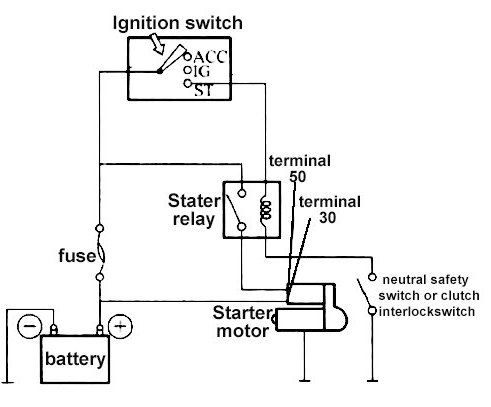Starter motor is activated by a starter switch, often part of the ignition key operation. This remote control activates a starter-mounted solenoid, which serves two primary functions. First, it acts as a solenoid to engage the pinion with the flywheel ring gear. Second, it acts as a relay to bridge the main starting terminals in the control circuit.
One important thing to note is that the starter solenoid is capable of handling high surge currents. These high currents are necessary to provide the initial jolt of power required to turn the engine over and start it.
What is a Starter Solenoid ?
When the ignition key is turned to the “start” position, the starter solenoid receives an electrical signal that energizes it. This activation triggers a plunger to move, connecting two significant electrical contacts within the solenoid.
This connection allows for the direct flow of high surge current from the vehicle’s battery, which is necessary to engage the starter motor and turn the engine over. Once the engine is running, the solenoid’s role is complete, and it disengages the high current flow to the starter motor.

Relay vs Solenoid
The terms “relay” and “solenoid” are often used interchangeably, and this can lead to confusion. Both devices are, in essence, remote electromagnetic switches that can control high-power signals with low-power signals.
So, while they work together as part of the starting system, the starter relay is primarily a control switch, and the starter solenoid is a combined electrical switch and mechanical engagement device.
What happens when a starter solenoid is bad ?
while starter solenoids are generally durable components, they can go bad over time. When a starter solenoid fails, it usually means that it’s not responding to the start signal sent by the relay. In this situation, the solenoid doesn’t actuate the plunger, and as a result, no power is delivered to the starter motor.
As a result, when you turn the ignition key, the vehicle won’t start. Even if the car’s battery is in good condition, a faulty starter solenoid could be one of the reasons why the car won’t crank at all but has power.
Signs of a Bad Starter Solenoid
Here are some common symptoms of a bad starter relay:
- RAPID CLICKING SOUND FROM THE SOLENOID: One common symptom of a bad starter solenoid is a rapid clicking sound coming from the solenoid. When you attempt to start your vehicle, the solenoid should engage with a single, solid click. However, if it’s faulty, it might produce a series of rapid clicks instead. This typically indicates that the solenoid is failing to engage and won’t transmit the necessary electrical current to the starter motor.
- No Response: One of the most common symptoms is when you turn the key and there is no response from the starter. There are no noises or engine cranking at all. Sometimes, repeated attempts may lead to a response, but it’s not guaranteed. This usually indicates a faulty connection in the solenoid.
- Grinding Noises: Bad starter solenoids can lead to grinding noises. In this case, the starter is cranking over, but the solenoid isn’t correctly pulling the shift lever back to engage the pinion gear with the flywheel. This results in the gears grinding against each other.
- Starter Remains Engaged: It’s also possible for the starter to stay engaged even after you’ve released the ignition. A short circuit inside the solenoid causes power to continuously bridge to the starter when the ignition is in the “on” position.
Other Issues That Present Starter Circuit
There are several problems in the starter circuit that can mimic the symptoms of a bad starter solenoid. These issues can make it seem like the solenoid is failing when it’s actually not the root cause. Some common problems include:
- Blown Starter Fuse: A blown starter fuse can indeed prevent the car from starting. If the starter fuse is blown, you may notice symptoms of a blown starter fuse.
- Bad Starter: A starter motor is generally a robust component, but it’s still important to be vigilant for any symptoms related to a bad starter.
- Bad Starter Relay: A bad starter relay can also cause issues with the car not starting due to problems in the starter circuit. Look for signs of a faulty starter relay, such as a clicking sound when you turn the key or the engine not turning over.
- Dead Battery : A dead battery can exhibit similar symptoms to a faulty starter solenoid.
Where is the Starter Solenoid Located ?
A starter solenoid is typically mounted on the starter motor or located near the battery in the engine compartment, depending on the specific vehicle’s design.
